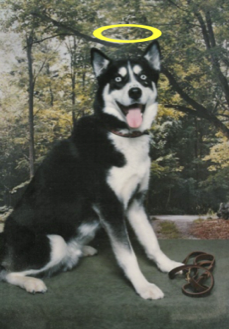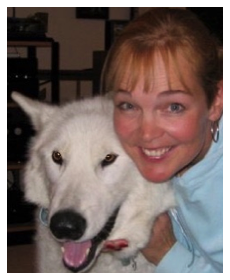How Dog Training Works
How do dogs learn? How does dog training work? In every household dog parents have different rules for their dogs: rules about furniture, access to rooms, how to play with children and other pets, how to greet guests and where to go to the bathroom. How can a dog learn these rules?
What to do about behavior you don’t like
We like to divide dog behavior into two categories:
1. attention getting behavior, like jumping up, playbiting, and barking at you.
2. everything else, like chewing on the wrong things, and digging.
Attention Getting Behavior
If you don’t like an attention getting behavior, you can either completely ignore the behavior or walk away. Ignoring the behavior is called extinction and the behavior will first increase in intensity before it goes away. That is called an extinction burst. Be sure not to give any attention to your dog at this point, otherwise you’re training the behavior to get much worse in a hurry.
Here is an example of what an extinction burst is: suppose you have locked yourself out of your house accidentally and you want to get back in. Your family is inside. You are going to look inside your brain to see which behavior has worked the most often in the past. In other words: which behavior has the biggest bank account. More than likely it is "ringing the doorbell." So you ring the doorbell. If nobody comes to open the door, what are you going to do? Ring the doorbell more frequently. If it still does not work, you will ring the doorbell faster and harder. That is an extinction burst. Eventually you will give up on ringing the doorbell and try a different behavior, like knocking. And again you will have an extinction burst "knocking" if it doesn't work right away.
Dogs learn by the consequences of their behavior. Every time their behavior gets them something they want, the behavior will increase in the future. Every time their behavior does not get them what they want, the behavior will decrease in the future. Dogs do what works for them and they don't do what doesn't work for them.
Every time a behavior works for them, it’s like putting a penny in the bank account for that behavior. The more money is in the bank account for a particular behavior, the more often we are going to see that behavior. Our goal is to build really big bank accounts for the behaviors we like. We also want to make sure that we don't end up building bank accounts for behaviors we don't like.
Training Mode
Once you have your management set up, you can start your dog’s training by only giving your dog the things he wants for behaviors you like. Then put some of those behaviors on cue, as in obedience training, so you can get those behaviors to happen whenever you want. The bigger your dog’s bank accounts become for “good” behaviors, the more freedom you can give your dog and the less management he is going to need.
Some examples:
- Once your dog has learned to go to his place, you would simply send him there before you sit down to eat.
- When a friend comes over, you tell your dog to sit and stay so that your dog won’t jump on your friend.
- Once your dog has learned to only go the bathroom outside, and which things are OK to chew on and which are not, he doesn’t have to be confined anymore and can have free rein in the house.
*A fun experiment: stand up straight with a treat in your hand. Make sure your dog sees the treat. He will then show you which behaviors he has the biggest bank accounts for. He will perform the behavior with the biggest bank account first, then the second biggest, and so forth.*
We are really good about this with young children. Suppose you have a young toddler. Would you go take a shower and let the little tike just wander around the house unsupervised? Of course not. You would confine the toddler to his crib or hand him to someone else to supervise.
Usually our biggest mistake with our dogs is that we give them too much freedom too soon. By doing that we set them up for failure. Then when they fail, we are mad at them. Not very fair is it?
Behavior that is not intended you get your attention
For behavior in the second category, you want to give your dog immediate feedback. For instance, if your dog goes to sniff something you don’t want him to touch, you can say “no, no” and get his attention away from the item. As soon as he moves away, say “good boy.” That is very clear feedback, a very clear Red Light, Green Light message. Of course, just like with human children, this has to be repeated a lot before the behavior goes away permanently. And again, consistency is key. And of course in this case, it would be even better to teach him a command like "leave it".
A faster way to get rid of attention getting behavior is to completely remove your attention. There are different levels of this. You could simply turn your face away. A little obvious drama goes a long way here. We usually combine it with a snort. Be sure not to keep looking at your dog, that is attention too. You could turn your back to your dog. That especially works well if, while turning away, you move your body closer to your dog. Dogs body block each other all the time. Body blocking is language dogs understand very well. Or you could storm out of the room, and get behind a closed door. When you time yourself out like this, only do it for 5 minutes or so, and repeat it as many times as necessary. That way your dog will learn that whenever he does that behavior, you temporarily leave him every time, so he gets anti-attention. Needless to say, consistency is key here.
Behavior Bank Accounts:

This article is a summary only of the protocol for behavior training.
For more information please call or text (303) 910-3931
Disclaimer: Please note that the information herein is provided as a free service. It does not create any form of legal or professional relationship and Affection & Praise Family Dog Training, Inc. does not accept any liability or responsibility for any action taken or avoided on the basis of information provided. It is dangerous to rely on generalized information or guidance. You should always seek independent professional advice in order that it can be tailored to your own individual circumstances.

Conclusion
To make sure that your dogs become angels instead of little devils, only reward behaviors that you like and make sure they don't get rewarded for behavior that you don't like. Of course putting the behaviors you like on cue is very helpful as well.
Always make sure that your dogs are getting the correct information from you, and please never assume they understand what you are talking about, unless you have specifically taught them the behavior, put the behavior on cue, and have put in the necessary amount of repetitions.
Different Kinds of Consequences
There are two ways we can motivate dogs to behave the way we want them to:
Positive Training
We can:
a) give them what they want, when they do what we want, and
b) withhold or withdraw those things when they don’t do what we want.
Negative Training
We can also do things to physically hurt them, scare them or intimidate them into doing what we want and visa versa. Choke chains (slip collars), pinch collars, shock collars, alpha rolls, yelling, throwing things etc. all fall in this category.
At Affection & Praise Family Dog Training, Inc. we only use positive training, because negative training can cause aggression, avoidance and numerous emotional and behavior problems.
"good boy"
"no, no"


Management Mode
When you get a new dog or puppy, you have two modes of being:
Training Mode: while you have eyes on your pup, you provide immediate feedback about his behavior, and
Management Mode: to prevent your pup from building any bank accounts for behaviors you don’t like, you can confine him to a dog proof area where he can’t get himself into trouble, such as a crate or a laundry room behind a puppy gate.
*Please note that collars and tags can get hung up on the bars of a crate or the bars of a gate, so please take off your dog's collar, and only get gates with vertical bars. We use this one: walk through gate. A walk through gate is much safer for you as well, because you won't risk falling while stepping over a gate.*
Here are some additional examples of management:
- Before you sit down to eat, you first give your dog a stuffed Kong so that he is busy and won’t bug you at the table.
- When a friend comes over, you first put your dog on leash and hold him back so he can’t jump up and get rewarded for it by your friend’s attention.

For instance, suppose that you are staying with a Dutch friend. You walk up to a book case and take out a book, then you walk to a comfy chair and sit down. Just then your friend angrily says “kom daar niet aan!!!” You most likely will jump out of the chair, thinking your friend doesn’t want you to sit there. However your friend said “don’t touch that book,” but her feedback was 2 seconds too late, so you misunderstood.
So what do dogs want? Most dogs want food, attention, play, toys, chews, a place to eliminate, a comfortable place to rest, and walks to check their pee-mail messages out there.
Basic obedience training is about teaching dogs behaviors that most of us like, such as sit, down, come, stay, etc. and then building really big bank accounts for those behaviors. That way, whenever dogs want something from us, they are most likely to ask for it by one of those “good” behaviors.
Common scenario: say that your dog wants attention and you are busy in the kitchen. He might walk over and sit in front of you to see if that will work. You are busy, so you ignore him. Your dog thinks “sitting doesn’t work, what else can I try? Let’s see if biting the ankles works.” When he bites your ankles, you push him away and say “no.” Your dog now thinks “biting the ankles works great! Not only did my human look at me and talk to me, but my human even wrestled with me. That’s exactly what I wanted.” All your dollars were put in the ankle biting bank account, and none in the sitting bank account. When your dog wants attention again, which behavior do you think he’s going to try first?
Timing of Consequences and Feedback
Dogs can only understand consequences and feedback that follow their behavior within one second. That is not because they don’t remember what they have done, but because they don’t speak any English. If you were in a foreign country, you would need immediate feedback too in order to understand what people wanted.
A full bank account. You are going to see this behavior a lot!
Almost empty bank account. You'll hardly ever see this behavior.

